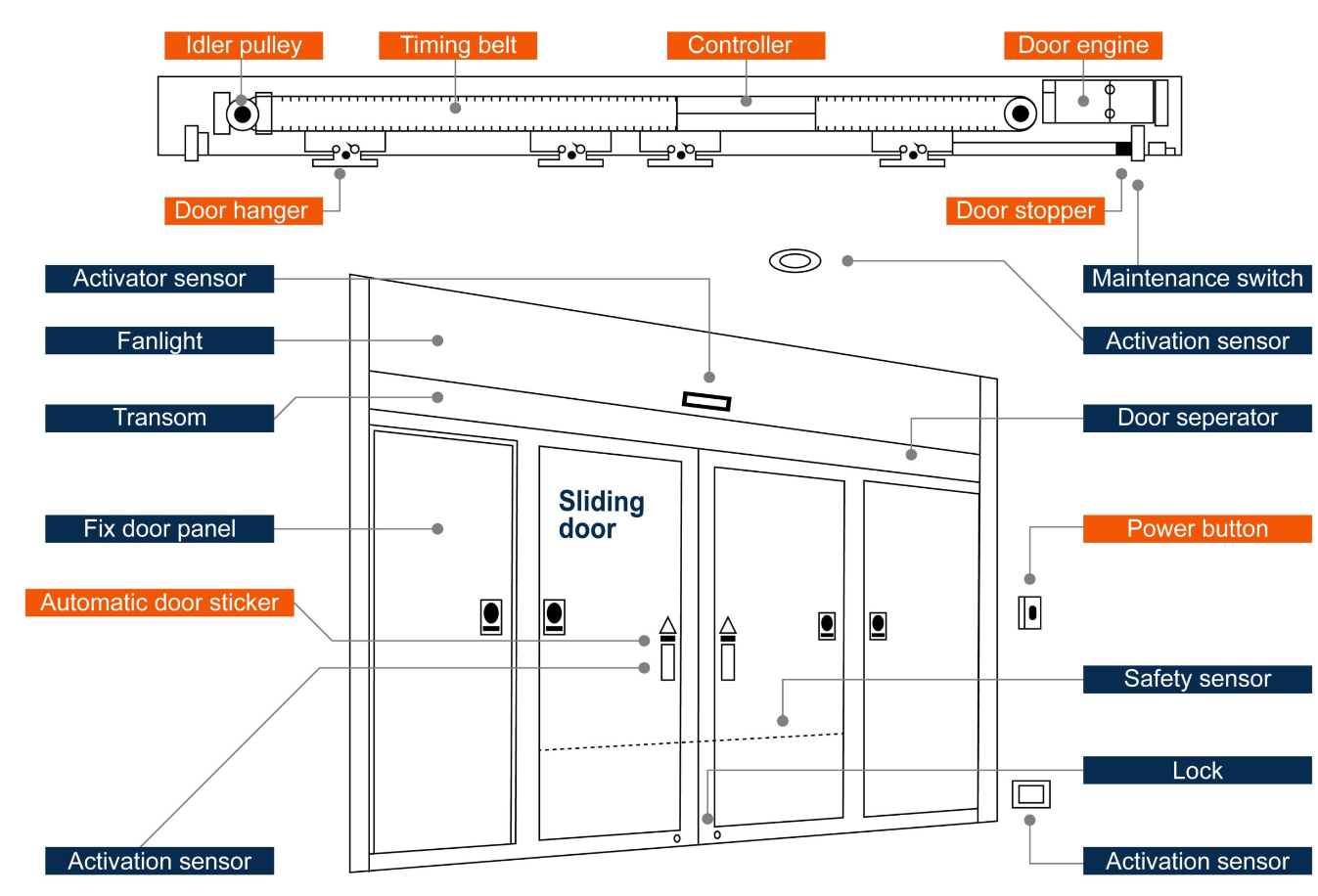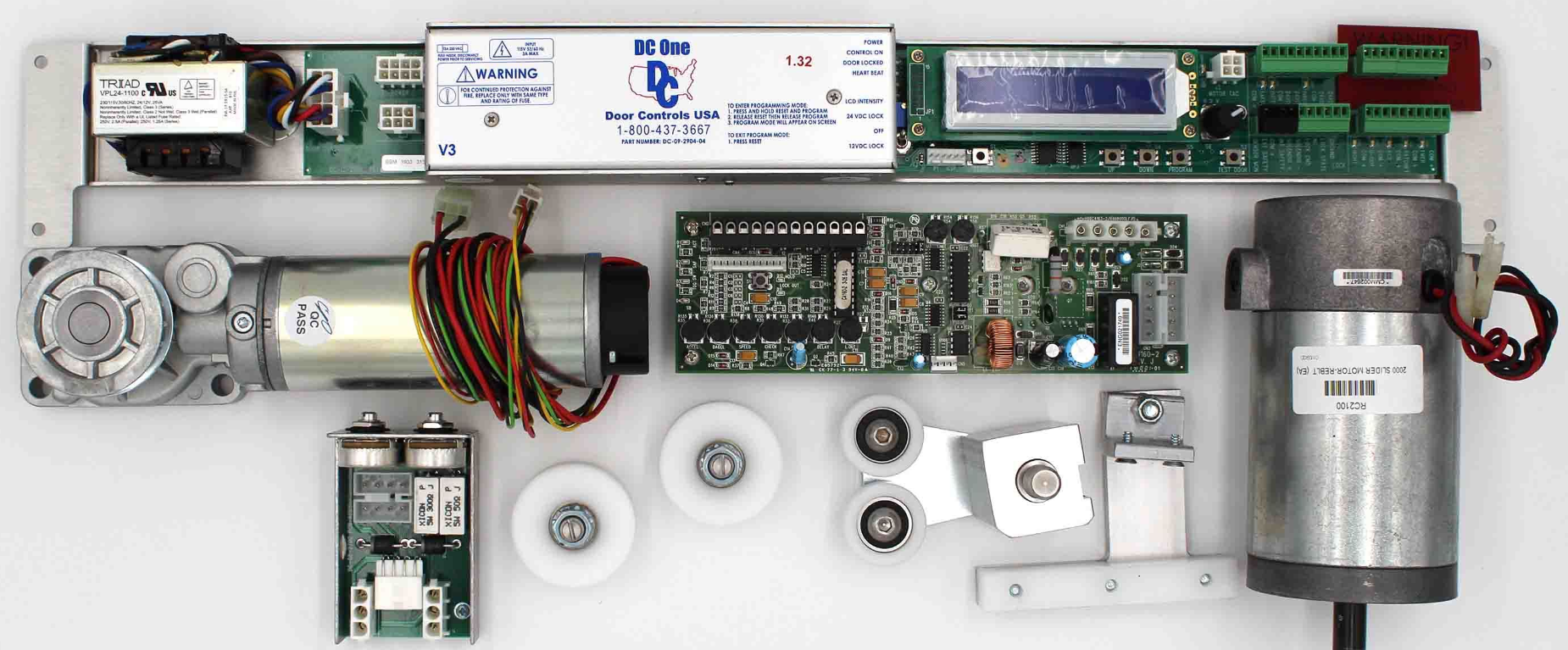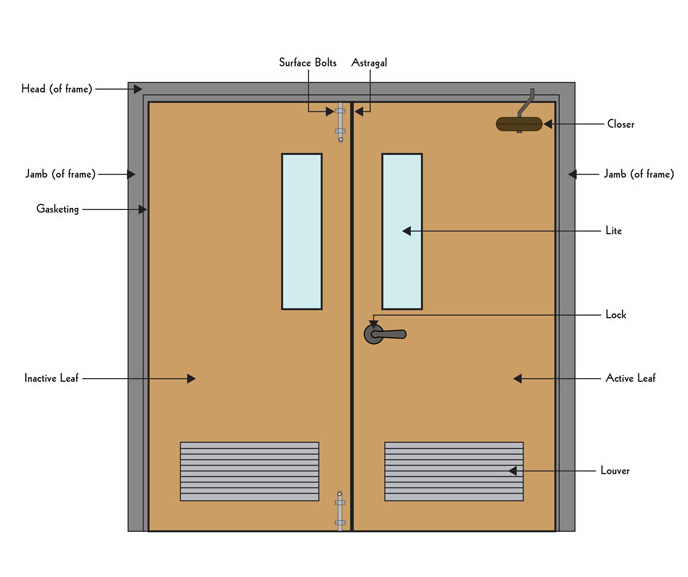An automatic door system comprises control units, door operators, sensors, access control systems, door panels, and various safety features.
Types of Automatic Doors
Sliding Doors
Sliding doors are perhaps the most common type of automatic doors you’ll encounter, especially in commercial settings like malls or airports.
Mechanism: A motor and a series of gears slide the door along a fixed track.
Materials: Typically made from glass, metal, or a combination of both.
Sensors: Utilize motion sensors or infrared sensors to detect movement or presence.
Advantages: Highly efficient in terms of space, and they offer a modern look.
Disadvantages: Cannot be used in curved entrances and they may have speed limitations.

Swinging Doors
Swinging doors are more traditional but can also be automated for ease of use, commonly seen in office environments.
Mechanism: Operated by a hydraulic arm or a pneumatic system, the door swings open around a hinge.
Materials: Wood, glass, or metal, often equipped with a push or pull handle for manual use.
Sensors: Employ pressure sensors or motion sensors for operation.
Advantages: Easier and less expensive to install than sliding doors.
Disadvantages: Require more space for the door swing radius and may be less efficient in high-traffic areas.
Folding Doors
Folding doors are less common but offer unique benefits for certain applications like residential patios or retail storefronts.
Mechanism: Doors are hinged together and fold upon one another as they open.
Materials: Often made of lightweight materials like vinyl or aluminum.
Sensors: Infrared sensors are most commonly used for these types of doors.
Advantages: Excellent for wide entrances and aesthetically pleasing.
Disadvantages: Typically slower to open and close and may require frequent maintenance.
Revolving Doors
Revolving doors offer a touch of elegance and efficiency, most commonly found in high-end hotels and large office buildings.
Mechanism: A central shaft allows the door to rotate in a circular motion.
Materials: Typically made of glass encased in a metal frame.
Sensors: Utilize motion sensors, and modern versions include speed control.
Advantages: Excellent for maintaining indoor temperatures and handling high foot traffic.
Disadvantages: Expensive to install and not suitable for emergency exits.
Door Panels
Material Options
When it comes to material options for door panels, you have a variety of choices depending on your needs and aesthetic preferences.
Wood: Wood provides a classic and warm aesthetic but may require regular maintenance to prevent warping or rotting.
Glass: Especially common in commercial settings, glass offers a sleek and modern look. The use of tempered glass can provide additional safety.
Metal: Aluminum or steel doors are durable and provide a high level of security. They are often used in industrial settings or secure entrances.
Composite: A combination of materials such as wood and metal can offer both aesthetic appeal and durability.
Plastics and Polymers: Lightweight and inexpensive, but not the best in terms of security or durability.
Design Aspects
Design elements can significantly impact both the functionality and aesthetic appeal of the door panel.
Color and Finish: The color can match or contrast with the surrounding architecture. Finishes can range from matte to glossy.
Transparency: Especially in glass doors, the level of transparency can vary. Frosted glass or smart glass that changes transparency is also an option.
Panels and Glazing: Multiple panels can be used in a single door for design or functionality, and glazing can add additional insulation or security features.
Handles and Accessories: These include items like handles, push bars, or electronic locking mechanisms that complement the door’s overall design and utility.
Dimensions: The size and shape of the door panel should accommodate the space and traffic needs, conforming to both safety regulations and design intentions.
Door Operators
Electric Motor
Electric motors stand as the most common type of operator in modern automatic doors, especially for sliding and revolving door setups.
Mechanism: An electric motor links to a gearbox that ultimately moves the door. The entire setup often operates on low voltage for safety reasons.
Speed and Force: Variable speed settings and force adjustments allow for different door behaviors, from slow, gentle movements to faster, more forceful openings.
Noise Level: Electric motors typically operate quietly, making them suitable for environments like hospitals or libraries where noise can be disruptive.
Energy Efficiency: Modern electric motors often come with energy-saving features. Some may even integrate with smart grid systems to optimize energy usage.
Maintenance: Generally requires less maintenance compared to hydraulic systems but can be susceptible to electrical issues.
Hydraulic Systems
Hydraulic door operators are more traditional and commonly found in swinging door setups, as well as heavy-duty applications.
Mechanism: Utilizes a hydraulic fluid-filled cylinder that moves a piston, which in turn moves the door.
Smooth Operation: One of the significant advantages is the smooth operation, providing a more graceful opening and closing experience.
Load Capacity: Hydraulics are often chosen for heavy doors, as they can handle significant weight without strain, making them ideal for industrial settings.
Temperature Resistance: Hydraulic systems usually perform well under extreme temperature conditions, making them suitable for environments that experience wide temperature fluctuations.
Maintenance: These systems generally require more frequent maintenance to ensure the hydraulic fluid levels are optimal and to prevent seal leaks.
Sensors
Motion Sensors
Motion sensors are commonly found in a variety of automatic door systems, particularly in commercial establishments like shopping malls and airports.
Technology: Motion sensors usually employ microwave or ultrasonic technology to detect movement in a defined area.
Sensitivity: Users can adjust the sensitivity settings depending on the application, ensuring that the door only opens when necessary to save energy.
Range: The operational range can also be customized. For instance, a longer range would be useful in high-traffic environments.
Advantages: Motion sensors are highly responsive and quick to activate the door, making them efficient for high-traffic areas.
Disadvantages: They may mistakenly pick up unintended movements, causing unnecessary openings.
Here’s a Wikipedia link for more information on motion sensors.
Infrared Sensors
Infrared sensors are frequently used in applications requiring a higher degree of sensitivity or specificity, such as hospital doors.
Technology: These sensors use infrared light waves to detect heat and movement, making them highly accurate.
Sensitivity and Range: Both can be adjusted to suit specific needs, reducing false triggers.
Advantages: Offers high accuracy and can even distinguish between a human and an inanimate object based on heat signatures.
Disadvantages: They can be more expensive and may require more frequent maintenance.
Learn more about infrared sensors on Wikipedia.
Pressure Sensors
Pressure sensors are commonly used in industrial settings or in applications where safety is a primary concern, like emergency exits.
Technology: These sensors work by detecting weight or force applied to a specific area, such as a mat placed in front of the door.
Sensitivity: The sensitivity usually cannot be adjusted as they are designed to respond to a specific amount of pressure.
Advantages: Highly reliable and excellent for safety applications. They don’t activate the door unless someone or something is directly in front of it.
Disadvantages: Limited in scope and not ideal for high-traffic areas as they require physical contact to activate.
Explore pressure sensors on Wikipedia for an in-depth understanding.

Control Units
Microcontrollers
Microcontrollers serve as the brains of the automatic door system, responsible for interpreting signals from sensors and commanding the door operators accordingly.
Types: Different types of microcontrollers are available, ranging from simple 8-bit to more complex 32-bit controllers.
I/O Ports: These ports are crucial for connecting sensors and actuators, providing the interface between hardware components.
Memory: Microcontrollers with more memory can store more complex programs and can be upgraded more easily in the future.
Advantages: Highly customizable, capable of supporting a wide range of functionalities and features.
Disadvantages: Require specialized expertise for programming and setup.
Learn more about microcontrollers on Wikipedia for a deeper understanding.
Software Algorithms
Software algorithms dictate the behavior of the automatic door, ensuring it operates smoothly and responds accurately to sensor inputs.
Programming Language: Algorithms can be written in languages like C++ or Python, depending on the microcontroller’s compatibility.
Logic: The software determines the door’s behavior, like how quickly it should open or close, or how long it should stay open.
Security Features: Advanced algorithms can include security measures like encryption or timed locking mechanisms.
Advantages: Allows for fine-tuning of door behavior and can be updated remotely in some cases.
Disadvantages: Software glitches can disrupt the entire system, and security vulnerabilities might be exploited if not properly maintained.
Discover more about algorithms on Wikipedia to better understand their role in control units.
Access Control Systems
Card Readers
Card readers are a popular choice for many commercial and residential buildings, offering a convenient and efficient method for secure access.
Technology: Card readers work by scanning a magnetic strip or RFID chip embedded in a card.
Speed: The process is quick, often granting access within a second of swiping or tapping the card.
Security Levels: Different levels of encryption can be set up on the cards to ensure security.
Advantages: Easy to distribute and replace, and users can carry them conveniently in their wallets.
Disadvantages: Cards can be lost, stolen, or duplicated, leading to potential security risks.
For a comprehensive look at card readers, check out Wikipedia’s article.
Biometric Systems
Biometric systems offer one of the most secure forms of access control, utilizing unique physical characteristics for identification.
Types: Various biometric systems exist, from fingerprint and eye scans to facial recognition.
Speed and Accuracy: These systems can be highly accurate but may take slightly longer than card readers to process.
Advantages: Almost impossible to duplicate, making it highly secure.
Disadvantages: Setting up a biometric system is generally more expensive and can raise privacy concerns.
Learn more about biometric systems on Wikipedia.
Keypads
Keypads are one of the older forms of electronic access control but are still widely used due to their simplicity and affordability.
Technology: Users enter a numerical code to gain access.
Customization: Codes can be easily changed, allowing for flexible security arrangements.
Advantages: Inexpensive and simple to install and operate.
Disadvantages: Codes can be easily shared or guessed, and the keypad may wear out, revealing frequently used numbers.
Here’s a Wikipedia link for keypads for more detailed information.

Safety Features
Emergency Stop
The emergency stop feature is a crucial element that can halt the operation of the automatic door instantly.
Activation: Usually involves pressing a prominently displayed button that’s easily accessible.
Response Time: Once activated, the door should stop moving immediately, preventing any further operation.
Usage Scenarios: Ideal for situations where there’s an obstruction or safety hazard that requires immediate intervention.
Advantages: Provides a quick and effective way to stop the door in emergencies.
Disadvantages: Can be triggered accidentally, causing unnecessary interruptions.
For more on emergency stop systems, refer to Wikipedia’s article on the subject.
Fail-Safe Mechanisms
Fail-safe mechanisms ensure that the door reverts to a safe state during malfunctions or power outages.
Types: Common fail-safes include gravity closures for swinging doors and magnetic releases for sliding doors.
Operation: Automatically engages when sensors or control units detect an issue or when the power goes out.
Advantages: Enhances safety by preventing the door from becoming a hazard in the event of a malfunction.
Disadvantages: May require additional hardware and complexity, increasing the initial setup cost.
Learn more about fail-safe mechanisms on Wikipedia.
Backup Power Supply
Having a backup power supply is essential for maintaining the door’s functionality even during power outages.
Types: Battery backups and uninterruptible power supplies (UPS) are common options.
Duration: The length of time the backup can sustain the door’s operations varies, but it’s generally for a limited period.
Switch Over: In the event of a power outage, the system should automatically switch to the backup power supply.
Advantages: Ensures continuous operation, enhancing both convenience and safety.
Disadvantages: Requires periodic maintenance and may need regular battery replacements.
Check out Wikipedia for backup power supplies to understand their importance better.
